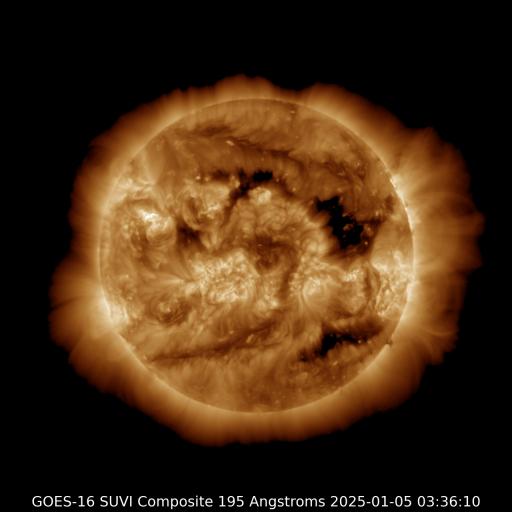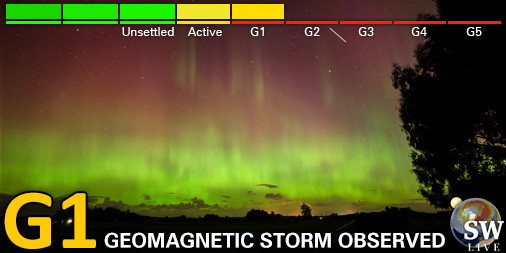Viewing archive of Tuesday, 27 October 2015
Daily bulletin on solar and geomagnetic activity from the SIDC
Issued: 2015 Oct 27 1230 UTC
SIDC Forecast
Solar flares
C-class flares expected, (probability >=50%)
Geomagnetism
Quiet (A<20 and K<4)
Solar protons
Quiet
| 10cm flux | Ap | |
|---|---|---|
| 27 Oct 2015 | 106 | 006 |
| 28 Oct 2015 | 106 | 007 |
| 29 Oct 2015 | 106 | 007 |
Bulletin
Solar activity was low. The X ray flux initially only briefly touched the C level with a C1 flare from Catania group 54 (NOAA 2436) peaking at 5:14UT. However, just before the end of the reporting period X-ray flux increased due to an ongoing C1.5 flare (peak at 12:11 UT) from a region at or beyond the East limb. The new Catania group 56 (NOAA 2440) grew as it was passing the central meridian with also another sunspot group (Catania 57) emerging behind it. Flaring is expected at C level mainly from the new regions, Catania 54 (NOAA2436) and the unnumbered region at the East limb. Yesterdays C2.1 flare seems to have caused a CME off the West limb, however currently available coronagraph images do not yet allow a conclusive analysis of its extent. Solar wind speed saw a gradual decline from around 480 km/s to 360 km/s. Total magnetic field also declined from around 6.8 nT to around 5 nT. Bz was between -3.5 nT and 4.4 nT. The magnetic field phi angle was stable in the positive sector. Geomagnetic conditions were quiet (both local K Dourbes and NOAA Kp 0-2). Solar wind conditions are expected to remain nominal with associated quiet geomagnetic conditions.
Today's estimated international sunspot number (ISN): 068, based on 18 stations.Solar indices for 26 Oct 2015
| Wolf number Catania | /// |
| 10cm solar flux | 106 |
| AK Chambon La Forêt | 005 |
| AK Wingst | 002 |
| Estimated Ap | 002 |
| Estimated international sunspot number | 071 - Based on 32 stations |
Noticeable events summary
| Day | Begin | Max | End | Loc | Strength | OP | 10cm | Catania/NOAA | Radio burst types | |
|---|---|---|---|---|---|---|---|---|---|---|
| None | ||||||||||
Provided by the Solar Influences Data analysis Center© - SIDC - Processed by SpaceWeatherLive
All times in UTC
Current data suggests there is a slight possibility for aurora to appear at the following high latitude regions in the near future
NuukLatest news
Latest forum messages
Support SpaceWeatherLive.com!
A lot of people come to SpaceWeatherLive to follow the Sun's activity or if there is aurora to be seen, but with more traffic comes higher server costs. Consider a donation if you enjoy SpaceWeatherLive so we can keep the website online!

Latest alerts
00:55 UTC - Coronal hole
A southern hemisphere coronal hole is facing Earth. Enhanced solar wind could arrive in ~3 days
Monday, 7 April 2025
20:45 UTC - Geomagnetic activity
Active geomagnetic conditions (Kp4) Threshold Reached: 20:39 UTC
17:33 UTC - Hemispheric Power Index
The OVATION model predicts the Hemispheric Power Index to reach 51GW at 18:18 UTC
Sunday, 6 April 2025
02:00 UTC - Geomagnetic activity
Minor G1 geomagnetic storm (Kp5) Threshold Reached: 01:50 UTC
Space weather facts
| Last X-flare | 2025/03/28 | X1.1 |
| Last M-flare | 2025/04/05 | M1.0 |
| Last geomagnetic storm | 2025/04/06 | Kp5 (G1) |
| Spotless days | |
|---|---|
| Last spotless day | 2022/06/08 |
| Monthly mean Sunspot Number | |
|---|---|
| March 2025 | 134.2 -20.4 |
| April 2025 | 148.7 +14.5 |
| Last 30 days | 134.1 -5.6 |





